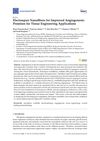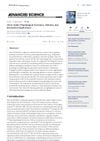Search
forLearn
2 / 2 resultslearn Osteopontin
signaling protein that, when suppressed, may grow hair by reducing inflammation and stem cell loss
Research
5 / 1000+ results
research Electrospun Nanofibers for Improved Angiogenesis: Promises for Tissue Engineering Applications
Electrospun nanofibers show promise for enhancing blood vessel growth in tissue engineering but need further research to improve their effectiveness.
research State-Of-The-Art Review Of Electrospun Gelatin-Based Nanofiber Dressings For Wound Healing Applications
Electrospun gelatin-based nanofiber dressings are promising for wound healing due to their effective healing properties and ability to protect against infections.
research 3D Bioprinting of Engineered Exosomes Secreted from M2-Polarized Macrophages Through Immunomodulatory Biomaterial Promotes In Vivo Wound Healing and Angiogenesis
3D bioprinting with special hydrogels helps heal wounds and grow new blood vessels.

research Nitric Oxide: Physiological Functions, Delivery, and Biomedical Applications
Nitric Oxide has potential in medicine, especially for infections and heart treatments, but its short life and delivery challenges limit its use.
research How Advancing Is Peripheral Nerve Regeneration Using Nanofiber Scaffolds? A Comprehensive Review of the Literature
Nanofiber scaffolds show promise for improving nerve healing.
Community Join
4 / 4 resultscommunity IGF-1 and Peptides? Miracle molecule waiting to be found
The conversation discusses potential hair loss treatments focusing on stimulating IGF-1 at the follicle level using growth-factor cocktails and engineered peptides, such as Acetyl Tetrapeptide-3, Copper Tripeptide-1, Oligopeptide-20, Thymosin-β4, and Palmitoyl Tetrapeptide-7. It suggests that device-assisted delivery methods like microneedling may enhance effectiveness.
community Minoxidil actually reduces wrinkles
Minoxidil may improve or worsen skin quality, with topical forms causing dryness and wrinkles, possibly due to alcohol content, while oral forms have fewer side effects. Some users consider using tretinoin to mitigate negative effects.
community Microneedling Isn’t Snake Oil — It’s Evidence-Based. Let’s Talk Studies, Not Fear.
Microneedling is supported by research as an effective adjuvant treatment for hair loss, especially when combined with Minoxidil or Finasteride, with minimal side effects if done properly. Concerns about long-term safety and potential risks like infection or fibrosis remain, but many users report positive results.

community Compressed part of research of theory of androgenic/anabolitic balance. AGA h-responders analytic. Theory of physio-metabolitic method of anti AGA treatment
The treatment for androgenetic alopecia involves using finasteride and minoxidil with intense exercise and cold exposure to boost metabolism and reduce androgenic effects, potentially leading to hair regrowth. This approach may activate biological pathways for improved hair and overall health.